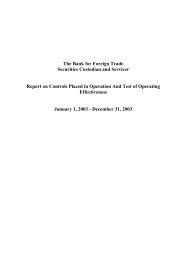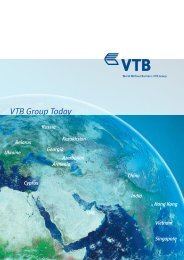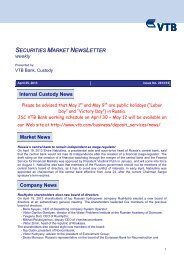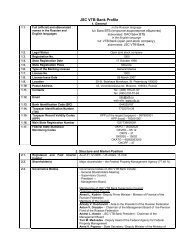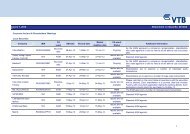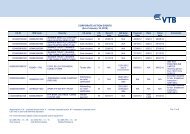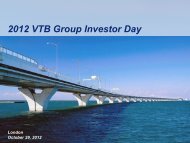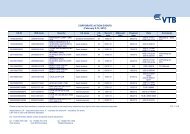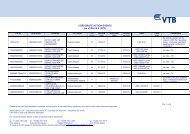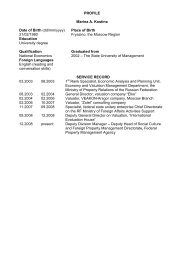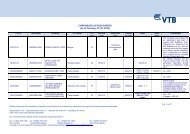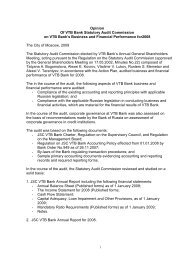Annual report 2011 - VTB
Annual report 2011 - VTB
Annual report 2011 - VTB
- No tags were found...
You also want an ePaper? Increase the reach of your titles
YUMPU automatically turns print PDFs into web optimized ePapers that Google loves.
<strong>VTB</strong> BankNotes to the Consolidated Financial Statements – 31 December <strong>2011</strong> and 2010(in billions of Russian Roubles)5. Summary of Principal Accounting Policies (continued)Investments in associates and joint ventures (continued)Venture Capital InvestmentsInvestments in companies that are managed as part of the Group’s investment portfolio of securities at fair valuethrough profit and loss and over which the Group may have significant influence are carried at fair value as permittedby IAS 28 which requires investments in associates that are held by venture capital organizations to be excluded fromthe scope of IAS 28 if these investments are designated upon initial recognition as at fair value through profit or lossor are classified as held for trading and accounted in accordance with IAS 39. These venture capital investments ofthe Group are classified as financial assets designated as at fair value through profit or loss and accountedaccordingly as described below.Financial assetsInitial recognition of financial assetsWhen financial assets are recognized initially, they are measured at fair value, plus, in the case of investments not atfair value through profit or loss, directly attributable transaction costs. The Group determines the classification of itsfinancial assets at initial recognition and subsequently can reclassify financial assets in certain cases as describedbelow.Fair value at initial recognition is best evidenced by the transaction price. A gain or loss on initial recognition is onlyrecorded if there is a difference between fair value and transaction price which can be evidenced by other observablecurrent market transactions in the same instrument or by a valuation technique whose inputs include only data fromobservable markets.The Group uses valuation techniques, which are based on discounted cash flow models and other pricing models, todetermine the fair value of financial assets that are not traded in an active market. For such assets differences mayarise between the fair value at initial recognition, which is considered to be the transaction price, and the amountdetermined at initial recognition using the valuation technique. Any such differences are not recognized as “day 1”gain or loss but rather are amortized on a straight line basis over the term of the relevant financial asset.Classification and reclassification of financial assetsFinancial assets in the scope of IAS 32 and IAS 39 are classified as either financial assets at fair value through profitor loss, loans and receivables, held-to-maturity investments, or available-for-sale financial assets, as appropriate.Financial assets at fair value through profit or loss:(a)Financial assets held for tradingFinancial assets classified as held for trading are included in the category ‘financial assets at fair value through profitor loss’. Financial assets are classified as held for trading if they are acquired or generated for the purpose of sellingin the near term. Derivatives are also classified as held for trading unless they are designated as and are effectivehedging instruments. Gains or losses on financial assets held for trading are recognized in the income statement.Financial assets held for trading, are either acquired for generating a profit from short-term fluctuations in price ortrader’s margin, or are securities included in a portfolio, in which a pattern of short-term trading exists. The Groupmay choose to reclassify a non-derivative trading financial asset out of the fair value through profit or loss category ifthe asset is no longer held for the purpose of selling it in the near term. Financial assets other than loans andreceivables are permitted to be reclassified out of fair value through profit or loss category only in rare circumstancesarising from a single event that is unusual and highly unlikely to reoccur in the near term. Financial assets classifiedas trading financial assets that would have met the definition of loans and receivables may be reclassified if theGroup has the intention and ability to hold these financial assets for the foreseeable future or until maturity.Non-derivative trading financial assets are carried at fair value. Interest earned on non-derivative debt tradingfinancial assets calculated using the effective interest method is presented in the income statement as interestincome. Dividends are included in dividend income within other operating income when the Group’s right to receivethe dividend payment is established. All elements of the changes in the fair value are recorded in the incomestatement as gains less losses from financial assets at fair value through profit or loss in the period, in which theyarise.13



